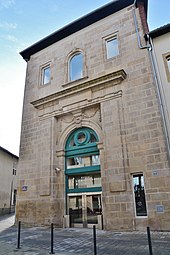Musée de la Resistance et de la Deportation de Limoges
The Musée de la Résistance et de la Déportation de Limoges is a museum in the French city of Limoges . His focus is on the resistance and liberation movement ( Résistance ) in the Limousin during the Second World War .
description
The museum is located in the former convent of the Sœurs de la Providence (Sisters of Providence) in the historic center of La Cité, not far from the Saint-Etienne cathedral . The address is 7 rue Neuve Saint-Etienne.
A total of around 800 exhibits are shown on two floors.
history
The Sœurs de la Providence had settled in Limoges around 1650 as part of the Counter Reformation . The first construction phase of the convent building falls in the years 1650 to 1670, but the architect is unknown. In 1779 the chapel and wings were rebuilt by Joseph Brousseau . During the French Revolution , the convent was confiscated as a Bien national and the order was dissolved in 1792. In 1833, the convent was expanded by the city of Limoges into a barracks with a crew of 200, which lasted until the end of the 19th century.
The current museum was completely redesigned between 2009 and 2012 and enlarged by 1200 square meters to 1400 square meters of exhibition space. The city of Limoges invested 7 million euros in this renovation work. Until 2012, the museum was still called the Musée de la Résistance et de la Déportation Henri-Chadourne , but then received the name that is valid today, which is often shortened to Musée de la Résistance de Limoges .
Goal setting
The museum shows a permanent exhibition on the history of the Resistance, the German occupation and the deportations in the Haute-Vienne department during the Second World War, spread over two floors and over 10 thematic halls . Temporary exhibitions are held in another room, as is currently the case with Anne Frank . There is also a classroom and a documentation center.
Starting in 1939, the circular route is divided into ten sequences. The underlying program is based on a scientific basis and was from that in France known historian Olivier Wieviorka compiled, specialists in the Second World War in central France Pascal Plas as well as the museum director Annie Martin.
Web links
- Musée de la Resistance de Limoges Reseau des Musée de la Resistance du Massif Central
Coordinates: 45 ° 49 ′ 49.4 " N , 1 ° 15 ′ 57.7" E

